Cascais-Portugal.com
The best independent guide to Cascais
Cascais-Portugal.com
The best independent guide to Cascais
The Cabo da Roca, Portugal; an independent travel guide for 2026
The Cabo da Roca is the wild and rugged headland that marks the most westerly point of mainland Europe. Until the 14th century, these towering cliffs and windswept lands were believed to be the edge of the world, and to this day the region possesses an aura of remoteness and rugged beauty.
The isolated ambience of Cabo da Roca is enhanced by the fact that there is very limited development within the area, with a lighthouse, coffee shop, gift shop and very little else. The primary draw of the Cabo da Roca is its wind-blasted and dramatic landscape, making it a real draw for tourists who appreciate nature’s raw beauty.
The Cabo da Roca is a popular destination with organised tours, being a stop between Sintra and Cascais, however it is easy to escape the coach-loads of tourists who come to take their photos here. These tours never stay long, due to the strong winds and often chilly weather. To truly avoid the crowds, take the scenic hiking trails that meander along the top of the cliffs, leading to pristine beaches such as the Praia da Ursa or Praia da Adraga.
This headland is a magical place to visit at sunset, with the golden glow of the setting sun reflected on the vast expanse of the Atlantic Ocean. The region is easiest visited by car or as part of a tour, but it is possible to travel here by public transport, with bus services departing both Sintra and Cascais.
Related articles: Cascais guide - Sintra guide
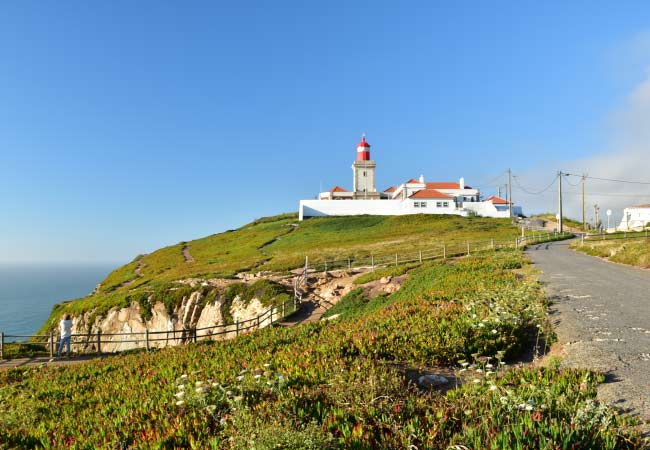
The Cabo da Roca cliffs and powerful lighthouse.
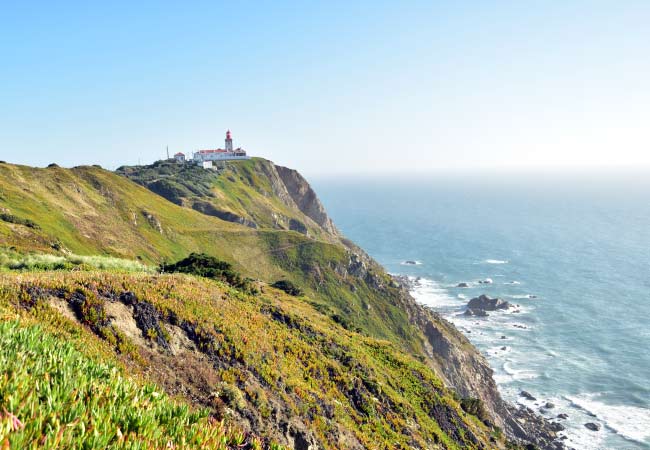
The northern side of the Cabo da Roca headland rarely gets any visitors and offers stunning hiking trails.
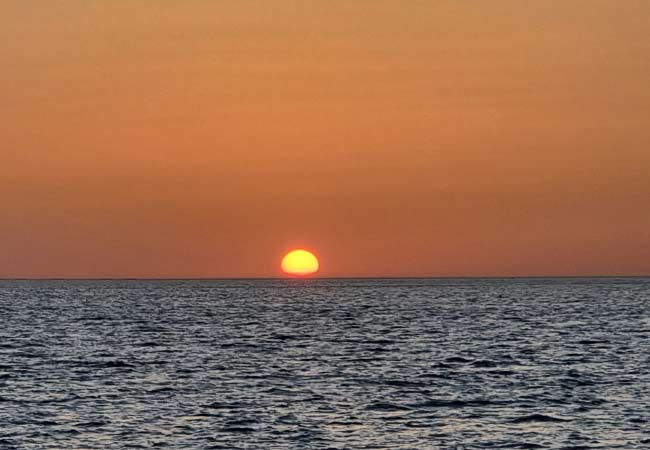
The Cabo da Roca is one of the most magical places to watch the sunset; just remember to wrap up warm.
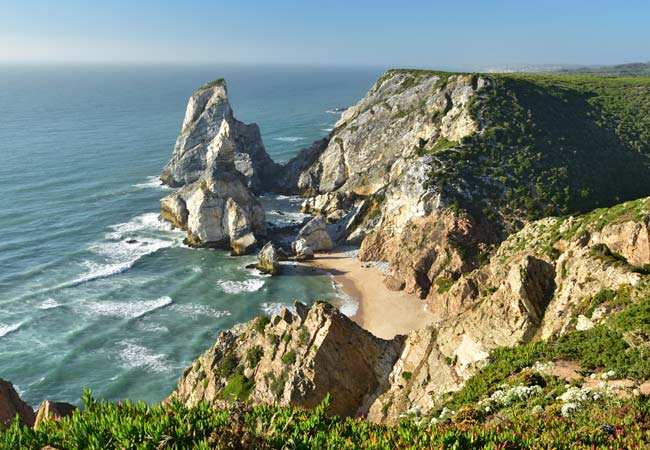
The Praia da Ursa beach, with its distinctive sea pillars, is only 1km (a 20-min hike) north of the Cabo da Roca.
It is always chilly at the Cabo da Roca
The Cabo da Roca cliffs and coastline of the Serra de Sintra have a unique and chilly microclimate, which can make it feel 10C cooler than in Cascais or Sintra.
The prevailing westerly winds draw in moisture-laden air from the Atlantic, which cools as it hits the cliffs and hills. This shrouds the area in fog and frequent rains, while in the summer there are very strong winds. The average wind speed for July to August is 15km/h (9mph).
For any extended visit to the Cabo da Roca, bring a jumper, jacket, or something to protect you from the ceaseless winds. These strong winds do have one advantage - they deter many tour groups from spending long here, while the footpaths and beaches will only have a handful of visitors.
Warning: The cliffs around Cabo da Roca are steep and unstable, while the strong winds are unpredictable – never go beyond the fences for the perfect photo.
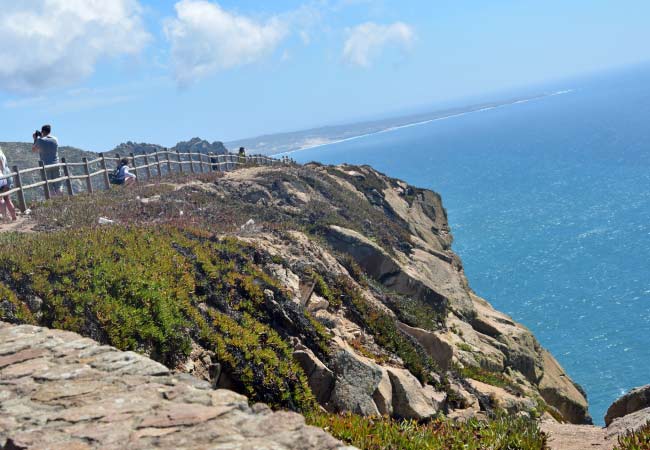
You do not want to be falling down these cliffs…
Tourist information for the Cabo da Roca
The Cabo da Roca is free to visit. Most visitors typically spend just 15 to 30 minutes here, which is enough time to view the cliffs, take a photo of the monument and see the lighthouse. This rushed experience is often encouraged by the coach tours, which make a brief stop here on their way between Sintra and Cascais.
At the site is the Restaurante Artesanato Bar, which serves drinks and simple food, as well as a Tourist Information Centre. Facilities at Cabo da Roca are basic and reflect the remote location. For any trip here, it is better to bring your own food or have eaten before visiting. There is a single toilet (€ 0.50) in the Tourist Information Centre, but it is always busy at peak times.
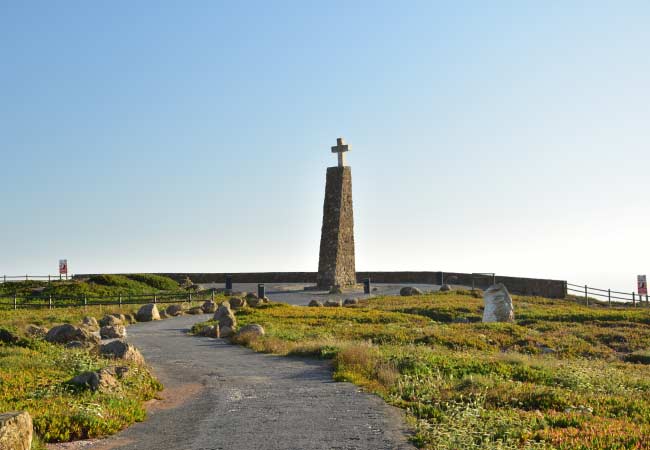
The ‘Ponta Mais Ocidental do Continente Europeu’ marker - just don’t expect it to be this quiet during your visit.
Google Street View of a typical day at the Cabo da Roca.
Travel to the Cabo da Roca
Cabo da Roca is 18km west of Sintra, 15km north of Cascais and 40km west of Lisbon, at GPS 38.7805, -9.497 - Link to google maps.
Driving is the easiest way to travel here, with the route from Cascais (and Lisbon) following the scenic N247 and turning off at the village of Azóia. The site is a further 2.5km out from the village and the route is well signposted.
If you don’t have a car and want a faster way to travel to the Cabo da Roca, a taxi or Uber/Bolt may be a better choice. A taxi from Sintra to Cabo da Roca will cost €25, while Bolt/Uber is €12 (these are the prices for one way). There can be very high demand for taxi, Uber and Bolt during the summer season, and the issue with all of them is trying to book a return ride from Cabo da Roca, due its remoteness.

A taxi to the Cabo da Roca from Sintra, but Uber and Bolt are cheaper.
Bus to the Cabo da Roca
Cabo da Roca is served by two bus services: the 1624 between Sintra and Cascais, and the 1253 from Sintra train station.
Note: The Cascais to Sintra service departs the Portela de Sintra train station, and does not go near the historic area of Sintra. Most visitors based in Sintra take the 1253.
The 1624 bus service is the longer route that connects Sintra and Cascais, which goes via the Cabo da Roca. A single ticket costs €2.60 (the return journey will need two single tickets, costing €5.20 in total). The bus takes 27 minutes to reach Cabo da Roca from Cascais or 35 minutes from Sintra.
There are two departures every hour, and thirty minutes is sufficient time to see everything at the Cabo da Roca. In Sintra, this service departs from the Portela de Sintra train station (GPS: 38.802, -9.376)
The bus service is seasonal, and the latest version of the timetable can be seen on the Carris Metropolitana website:
www.carris
If you are based in the historic centre of Sintra, the 1253 bus route is often the better option as it departs from outside Sintra train station GPS; 38.7998, -9.385
The 1253 bus follows a circular route around western Sintra, and the journey to the Cabo da Roca takes 40 minutes. There are two to three departures per hour, and a single ticket costs €2.60. The timetable for the 1253 bus route can be seen on the Carris Metropolitana website:
www.carris
Insight: All bus services in the metropolitan area of Lisbon (including Sintra and Cascais) are operated by Carris Metropolitana. This changed from Scotturb in January 2023, and the old Scotturb bus service to Cabo da Roca (route 403) may still be mentioned in some tourist guides. Scotturb still operates all of the tourist bus services in Sintra, such as the 434 to the Palácio Nacional da Pena.
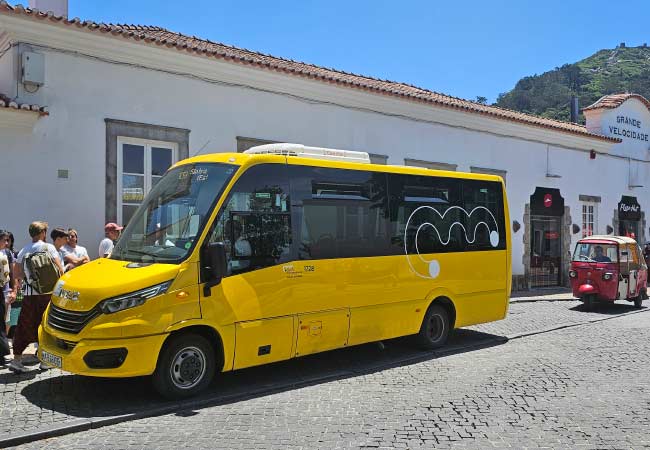
The 1253 bus waiting outside Sintra train station.
Hiking and the region’s undiscovered beaches
Leading from Cabo da Roca are numerous paths, but all either head in a northerly or southerly direction.
To the north are the Praia da Ursa (1km) and Praia da Adraga (2km) beaches, which are accessible by well-worn footpaths. The Praia da Ursa is regarded as one of the hidden gems of the Serra de Sintra region, with a picturesque natural setting, golden sands and unique rock formations. Further north is the Praia Grande and the charming resort town of Praia das Maçãs.
The southern footpath follows the cliffs and passes the Praia de Assentiz (800m) and the Praia do Louriçal (1km), before the main path heads inland. Some very small trails continue along the coastline.
The Praia de Assentiz and Praia do Louriçal beaches are not sensibly accessible from the cliffs; there is a rope access from the Praia do Louriçal for people who get stranded at the base of the cliffs!
If you are planning a walk, heading north is the better option.
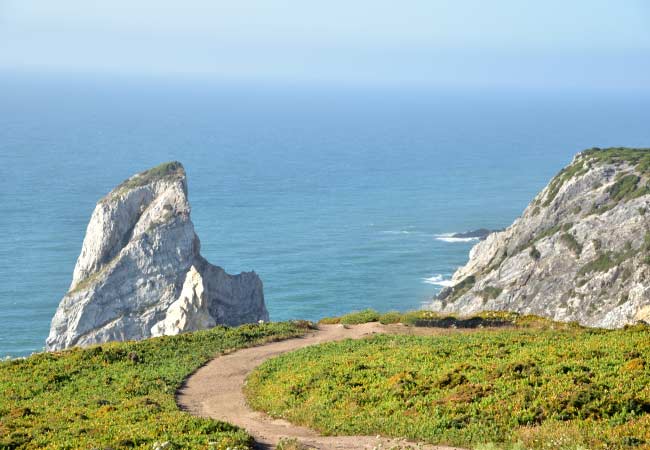
The path northwards to the Praia da Ursa.
Interesting facts about Cabo da Roca Portugal
The Cabo da Roca lighthouse was the first purpose-built lighthouse in Portugal and was completed in 1772, but its present form originates from 1842. The lighthouse stands 150m above the ocean, with its height meaning that the 1,000-watt light can be seen 46km away.
The ceaseless winds make it inhospitable for most plant life, and any must be low-lying and able to survive in the high-saline conditions. The dominant plant is the Hottentot fig (often known as the Ice-plant), a non-native Portuguese species. The Hottentot fig has flourished in the harsh conditions after spreading from a local garden three decades ago.
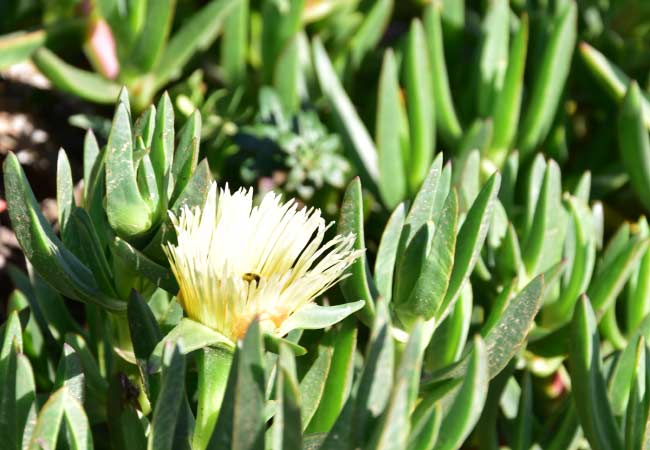
The yellow flower of the Hottentot fig.
The Cabo da Roca headland is marked by a stone monument, which is inscribed with a quote from Portugal’s most famous poet, Luís Vaz de Camões (1524–1580), who brilliantly described the area as "Where the land ends and the sea begins".
If you've found our content valuable, we'd welcome your support.
The digital publishing landscape has evolved significantly. As a small independent publisher, we face growing challenges. Search engines increasingly favour paid content over organic results, while AI-generated content often reproduces original work without attribution.
To support our work, please consider bookmarking this page (press Ctrl + D) for quick access. If you find an article helpful, we'd be grateful if you'd share it with friends on social media.
For specific questions, please see our Reddit community at r/LisbonPortugalTravel.
Should you notice any outdated or incorrect information, please contact us at [email protected]
Thank you for helping us continue to provide valuable content in an increasingly challenging digital environment.


























